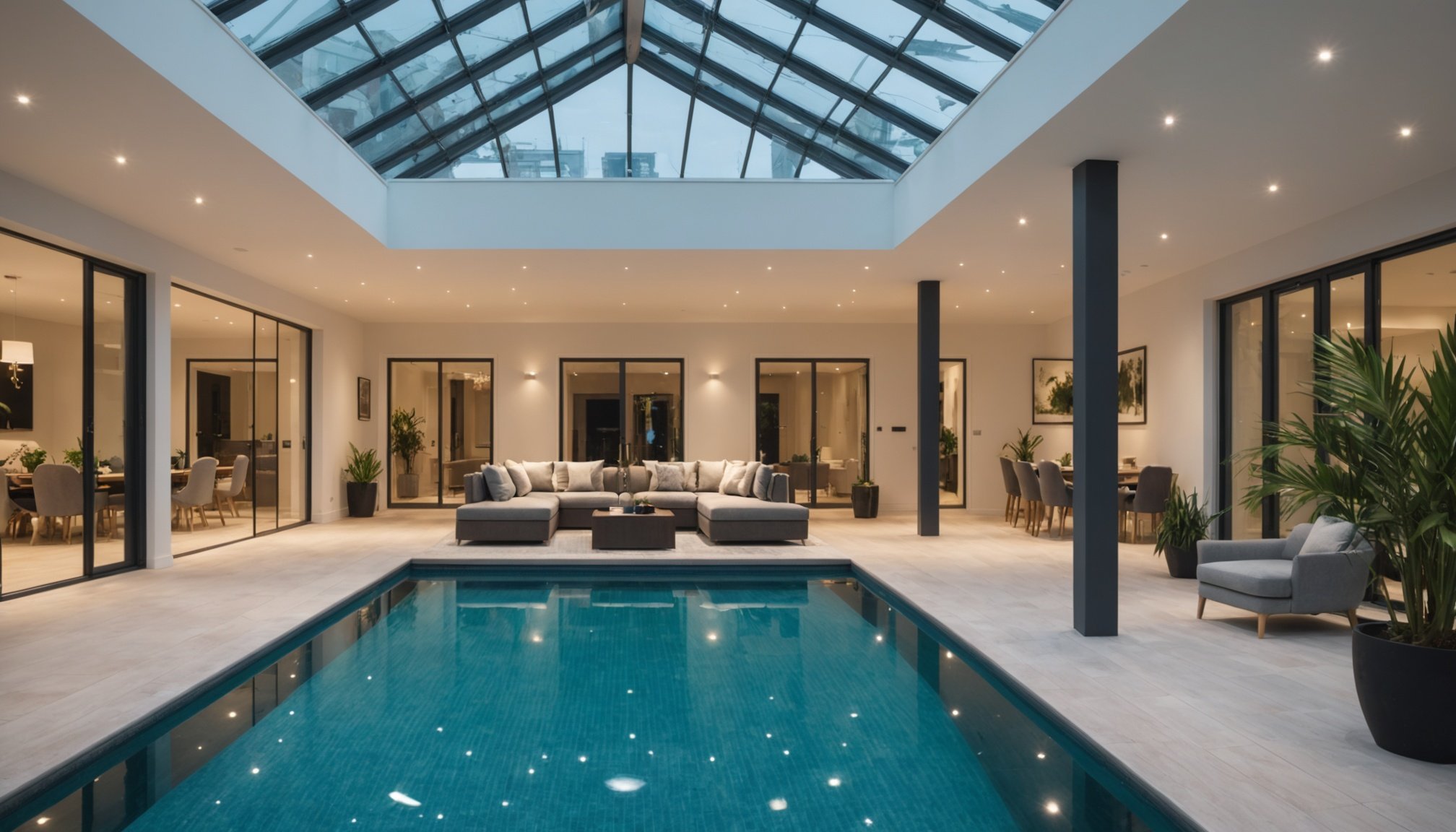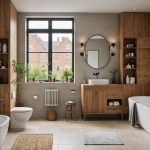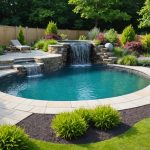Understanding the Dual-Purpose Pool Concept
Owning a dual-purpose pool provides homeowners with an enhanced and flexible outdoor experience. These pools uniquely combine the allure of a tranquil oasis for relaxation with the practicality of a fitness space. The ability to switch between a serene lounging area and a workout hub makes them a valuable addition to any property.
In terms of pool design, balancing both relaxation and fitness calls for ingenuity and careful planning. A prevalent design principle involves incorporating varying depths—shallower sections for leisure activities like sunbathing, and deeper zones suitable for swimming laps. Additionally, features such as dedicated swim lanes or resistance jets can effortlessly transform a relaxation pool into a fitness arena.
Also read : Transform Your UK Home: Designing a Safe and Fun Pool Area for Kids
Key features that define a dual-purpose pool include multifunctional spaces and adaptable elements. For instance, incorporating built-in benches or ledges serves dual functions: a place to unwind and sit, or a foothold for water exercises. Similarly, strategically placed lighting can enhance the mood, serving a calming ambiance for evening relaxation while ensuring safety during exercise sessions.
Ultimately, the beauty of these pools lies in their versatile nature, providing the ultimate in leisure and fitness, perfectly tailored for diverse homeowner needs. Whether lounging or exercising, dual-purpose pools offer an optimal blend of aesthetics and utility.
Topic to read : Transform Your UK Garden: Creative Ideas for Designing a Stunning Pool with a Waterfall Feature
Design Concepts for a Dual-Purpose Pool
Crafting a dual-purpose pool requires an astute approach to blend both fitness and relaxation needs seamlessly. Central to the concept is how pool design ideas shape versatile spaces.
Layout and Space Considerations
The arrangement of the pool space should enable efficient utilization for activities like water aerobics and unwinding alike. Consider the pool depth and dimensions carefully, as they play a pivotal role in accommodating swimming pools that support diverse uses. Moreover, thoughtful integration of landscaping can transform the environment, ensuring it delivers a cohesive look that pleases aesthetically.
Essential Features for Fitness
Swim lanes or resistance jets are critical for maintaining a regimen of aquatic exercises. Such features support the creation of versatile spaces, allowing users to engage in both professional swimming and fitness activities. Moreover, choose materials that offer durability and safety, keeping in mind the demanding nature of fitness tasks.
Relaxation Elements
Design aesthetics are crucial when incorporating jacuzzi sections or spa areas into pool design ideas. Consider how lighting and finishes can amplify relaxation and tranquility. Privacy is another consideration; landscaping elements like hedges or poolside structures can provide a more intimate environment suitable for unwinding.
Maintenance and Upkeep of Your Pool
Maintaining your pool efficiently begins with establishing a regular maintenance routine. This not only ensures health and safety but also preserves water quality. Pool maintenance should include skimming the surface of the pool, checking water levels, and performing timely inspection of the pool equipment.
To ensure optimal water quality, focus on effective filtration. Clean or backwash your pool filter regularly to remove debris and contaminants. Equally important is maintaining proper chemical levels. Regularly test the pH balance, alkalinity, and chlorine levels, adjusting as needed. A balanced chemical environment assists in warding off algae and bacteria growth, ensuring your pool remains a safe haven for swimming.
Understanding seasonal considerations, especially in UK climates, is crucial. During the winter months, it may be wise to partially drain the pool and cover it to prevent debris buildup and damage from freezing temperatures. In contrast, spring may require a thorough inspection and additional chemical balancing to prepare for the swimming season.
By adhering to these upkeep tips, pool owners can effectively manage their pools, preserving both its structural integrity and inviting nature. Regular attention to these aspects makes pool maintenance both manageable and rewarding, ensuring your pool stays inviting year-round.
Fitness Integration Ideas
Incorporating fitness pools into your routine can be a fun and effective way to stay active while enjoying the benefits of water.
Tailored Fitness Programs
Customized fitness programs can maximize the use of fitness pools. For swim training, consider workouts that incorporate different strokes and intervals. This not only improves cardiovascular endurance but also builds muscle strength. To enhance training, utilize swim technology such as waterproof fitness trackers. These gadgets help monitor progress, offering real-time feedback on performance metrics like laps, speed, and calories burned.
When deciding between group or individual fitness sessions, it’s important to assess your personal objectives. Group sessions motivate through camaraderie, while individual sessions offer personal attention and a focus on specific goals.
Family-Friendly Activities
Fitness pools are not just for serious workouts; they are also perfect for family fun. Tailor activities like water polo and relay races to engage all ages. For children, water-based games like treasure hunts or obstacle courses can turn exercise into an enjoyable activity. These moments encourage a love for physical activity while fostering community. Hosting social gatherings centered around pool activities provides a relaxed environment for fitness and fun. These events can range from casual pool parties to coordinated aquatic fitness classes, offering a diverse array of engagement opportunities for everyone involved.
Relaxation Features and Enhancements
Creating the ultimate relaxation zone involves a careful selection of amenities. Loungers and shaded areas are pivotal, offering a comfortable retreat where one can unwind, away from the hustle and bustle. These elements create an environment conducive to relaxation and mental peace.
Integrating spa features like aromatherapy and hydrotherapy can significantly enhance your relaxation experience. Aromatherapy, through essential oils, can uplift your mood and reduce stress, while hydrotherapy utilizes water to soothe and relax muscles, offering a holistic approach to wellness.
Imagine being enveloped by calming sounds and visuals, which play a critical role in relaxation zones. Consider the gentle whisper of wind through leaves or the soft lapping of water for a natural soundscape. Visual elements, such as tranquil waterscapes or serene garden views, can also create a peaceful atmosphere. These relaxation techniques combine sound and sights to transport you to a state of calm.
Incorporating the right amenities and features can transform any space into a sanctuary of tranquility. The fusion of comfortable seating, sensory therapies, and serene multimedia creates an oasis of relaxation.
Regional Construction Regulations and Considerations
When considering building a pool in the UK, it’s crucial to be aware of specific UK pool regulations and construction guidelines. The regulations are designed to ensure that residential pools meet stringent safety standards to protect homeowners and the public.
In the UK, residential pools are subject to a variety of construction guidelines. The primary focus of these guidelines is to safeguard against accidents and enhance pool safety. For instance, pools should have secure fencing and self-closing gates to prevent unguarded access. Additionally, anti-slip surfaces around the pool area are a necessity to mitigate the risk of slipping.
Before constructing a pool, obtaining planning permission is often required. This can depend on the size and location of the pool as well as local council requirements. Failing to comply can result in penalties or the dismantling of the pool.
Potential costs involved in compliance with these regulations should be anticipated. These costs may include fees for planning applications, alterations to property infrastructure, or installing additional safety features. While these outlays might seem daunting, ensuring adherence to safety standards is paramount for the longevity and legal standing of the pool, emphasizing the importance of compliance in pool construction projects.
Cost Breakdown for Creating Your Pool
Planning a pool is a thrilling yet expensive venture. Understanding the pool installation cost and managing a budget effectively can save both time and money.
Initial Setup Costs
The cost analysis for pool installation begins with the materials and construction expenses. On average, these costs can vary depending on the type of pool—be it fibreglass, vinyl, or concrete. For those opting for professional services, include labour costs in your assessment. Conversely, DIY options might seem cheaper but could lead to extra expenses if mistakes occur.
Consider integrating the pool with the existing landscape. This can entail additional costs for landscaping and potential changes to your property’s layout. It is essential to assess these factors beforehand to prevent overspending.
Ongoing Expenses
Pool ownership comes with several ongoing expenses. Utility costs, for instance, include electricity for pool pumps and heaters. Investing in quality equipment, such as cleaning tools or safety barriers, ensures longevity and safety, albeit raising costs. Do not overlook insurance for your pool—it protects against liabilities and potential mishaps.
Potential Return on Investment
A well-designed pool can significantly enhance your home’s value. As per recent market trends, dual-purpose pools, which combine aesthetics with functionality, are increasingly popular in the UK. When done right, a pool installation can positively impact property value, making it a strategic investment.











